
Last modified:
DISCLAIMER: This English version is translated from the original French. In case of any discrepancy, the French version shall prevail.
| Author: | Beauchamp, 2020 |
| Age: | Mesoarchean |
| Stratotype: | None |
| Type area: | Cadieux Lake and Bohier Island areas (NTS sheets 33A01 and 33A02) |
| Geological province: | Superior Province |
| Geological subdivision: | Opatica Subprovince |
| Lithology: | Tonalite and granodiorite |
| Category: | Lithodemic |
| Rank: | Lithodeme |
| Status: | Formal |
| Use: | Active |
None
Background
In the Bohier Island geological map, Beauchamp et al. (2018) mapped part of the Digne Pluton, but associated it with the Misasque Complex. The Digne Pluton was introduced in 2020 following geological mapping of the Cadieux Lake project (Beauchamp, 2020). This intrusion individualizes a very homogeneous tonalitic to granodioritic mass from its adjacent unit, the Misasque Complex, which is a heterogeneous assemblage of tonalitic to granitic gneiss, dioritic gneiss, tonalite, granodiorite and granite.
Description
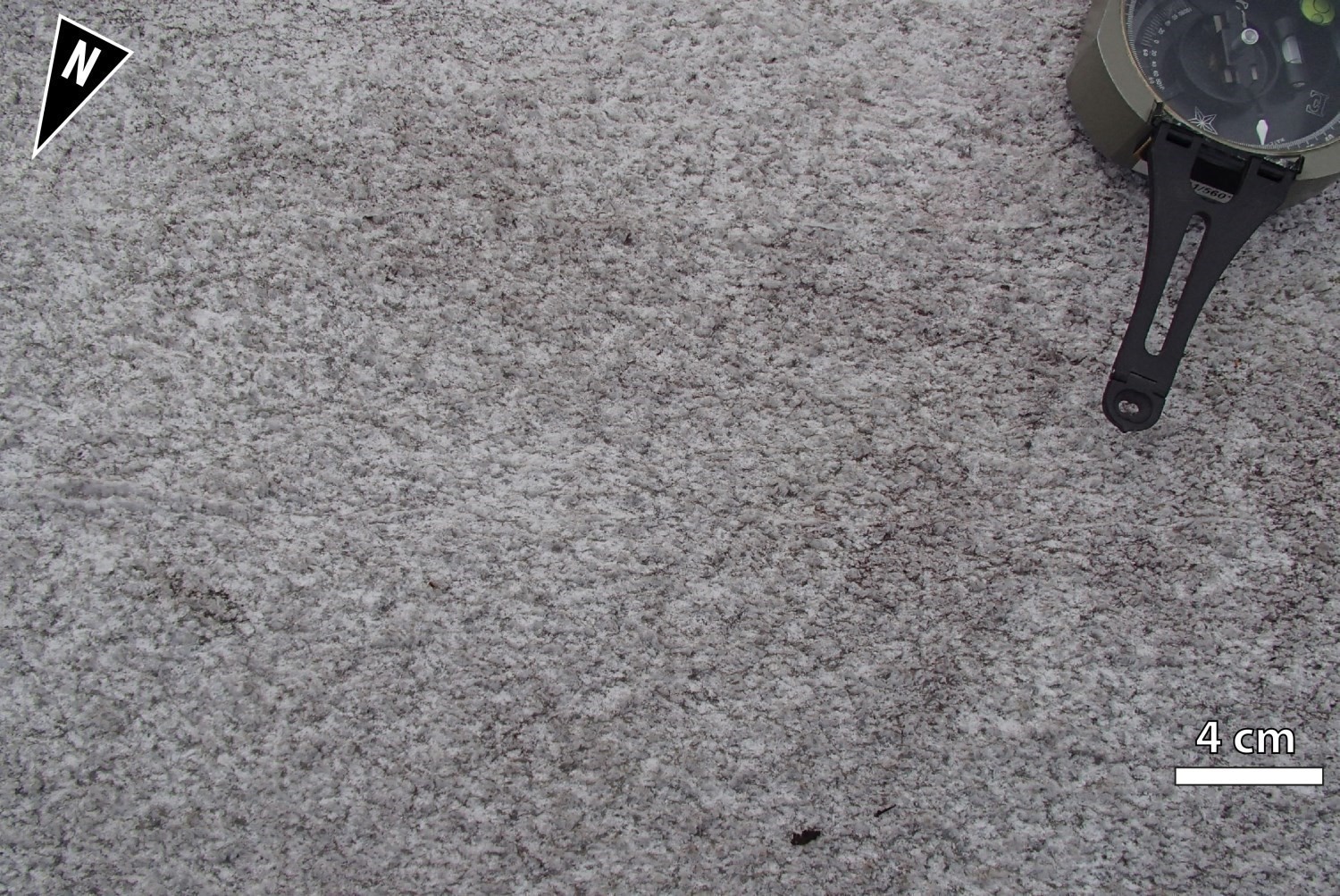
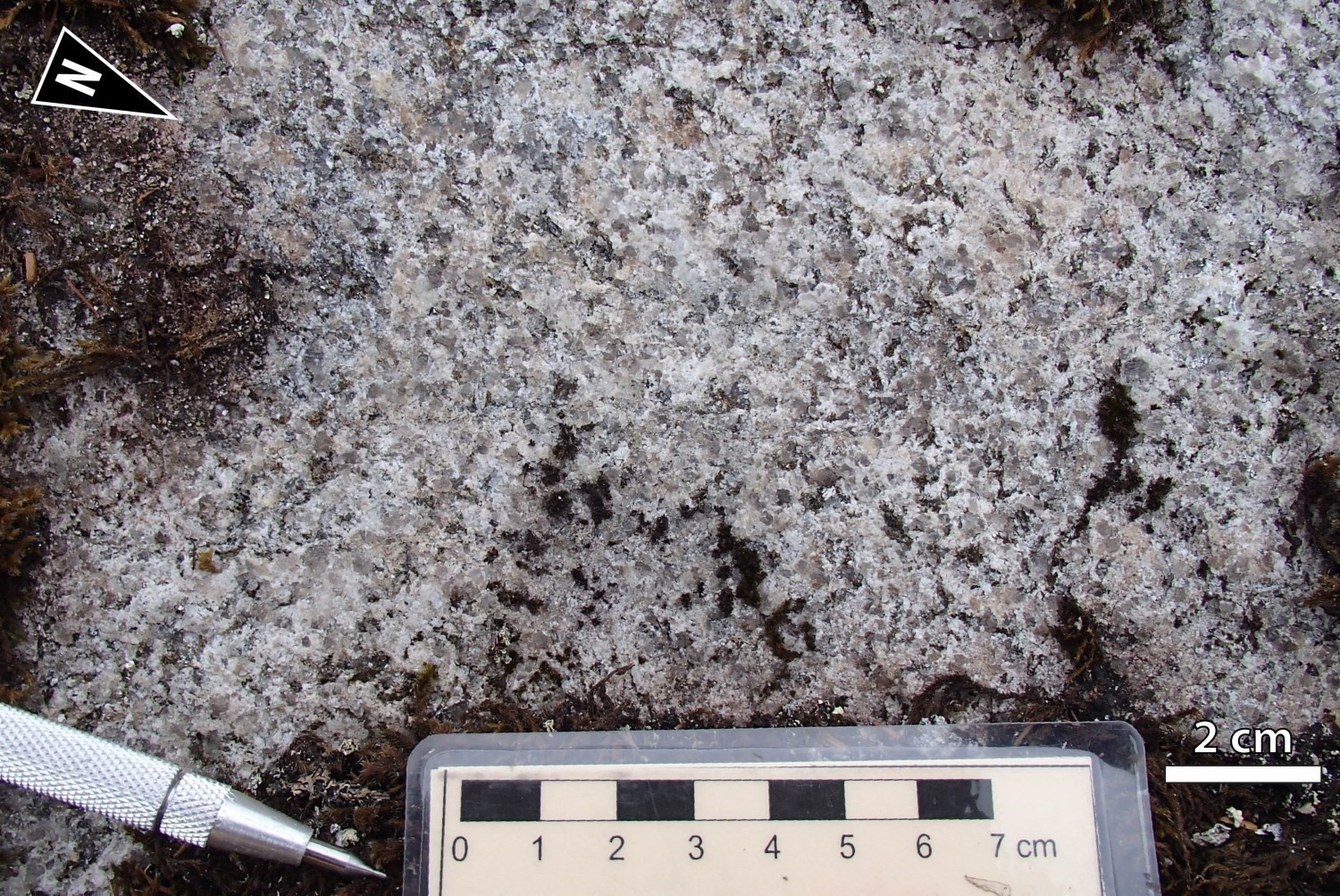
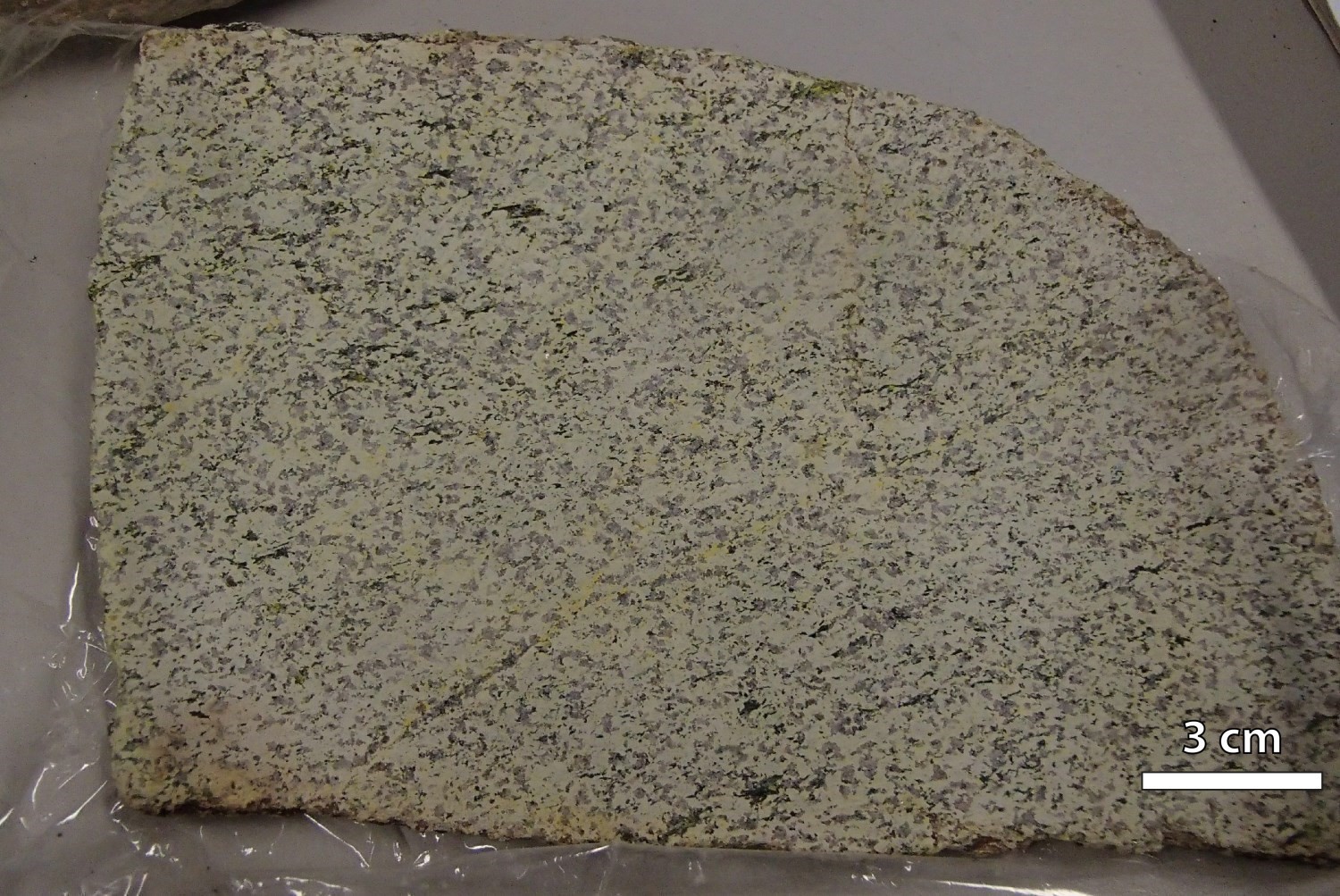
 The Digne Pluton is composed mainly of tonalite and a lesser amount of granodiorite. The pluton is characterized by low magnetic susceptibility. The rock is white to very light grey in altered surface and white-grey and slightly darker in fresh exposure. It is homogeneous, medium grained, even grained and appears little deformed. This unit is leucocratic and contains <7% ferromagnesian minerals. Except quartz and feldspar, the main minerals are biotite (2-5%), muscovite (≤4%), chlorite and hornblende in some places. Muscovite forms shredded flakes parallel to foliation or locally cutting biotite. Staining shows that this unit has an abundance of plagioclase with respect to K-feldspar. Microcline is observed as small interstitial grains. Accessory minerals consist of epidote, garnet, calcite, apatite, zircon and opaque minerals. The Digne Pluton differs from adjacent units by its homogeneity and the presence of quartz phenocrystals surrounded by finer feldspar grains.
The Digne Pluton is composed mainly of tonalite and a lesser amount of granodiorite. The pluton is characterized by low magnetic susceptibility. The rock is white to very light grey in altered surface and white-grey and slightly darker in fresh exposure. It is homogeneous, medium grained, even grained and appears little deformed. This unit is leucocratic and contains <7% ferromagnesian minerals. Except quartz and feldspar, the main minerals are biotite (2-5%), muscovite (≤4%), chlorite and hornblende in some places. Muscovite forms shredded flakes parallel to foliation or locally cutting biotite. Staining shows that this unit has an abundance of plagioclase with respect to K-feldspar. Microcline is observed as small interstitial grains. Accessory minerals consist of epidote, garnet, calcite, apatite, zircon and opaque minerals. The Digne Pluton differs from adjacent units by its homogeneity and the presence of quartz phenocrystals surrounded by finer feldspar grains.
The main foliation is weakly to moderately developed and is marked by the alignment of chloritized biotite and muscovite in clusters and by the elongation of quartz. Stretch lineation, when present, is marked by the alignment of small biotite aggregates and by stretching of quartz. As they approach the Digne Shear Zone, Digne Pluton rocks are more deformed. They become L>>S tectonites altered to chlorite or muscovite or calcite. Locally, rocks of the Digne Pluton are highly altered. They are similar to muscovite schist cut by a quartz vein network. Muscovitization of the rock is reminiscent of greisen-type alteration associated with hydrothermal circulation linked to the emplacement of peraluminous plutons (outcrops 18-PG-4044, 18-PG-4045 and 18-PG-4046).
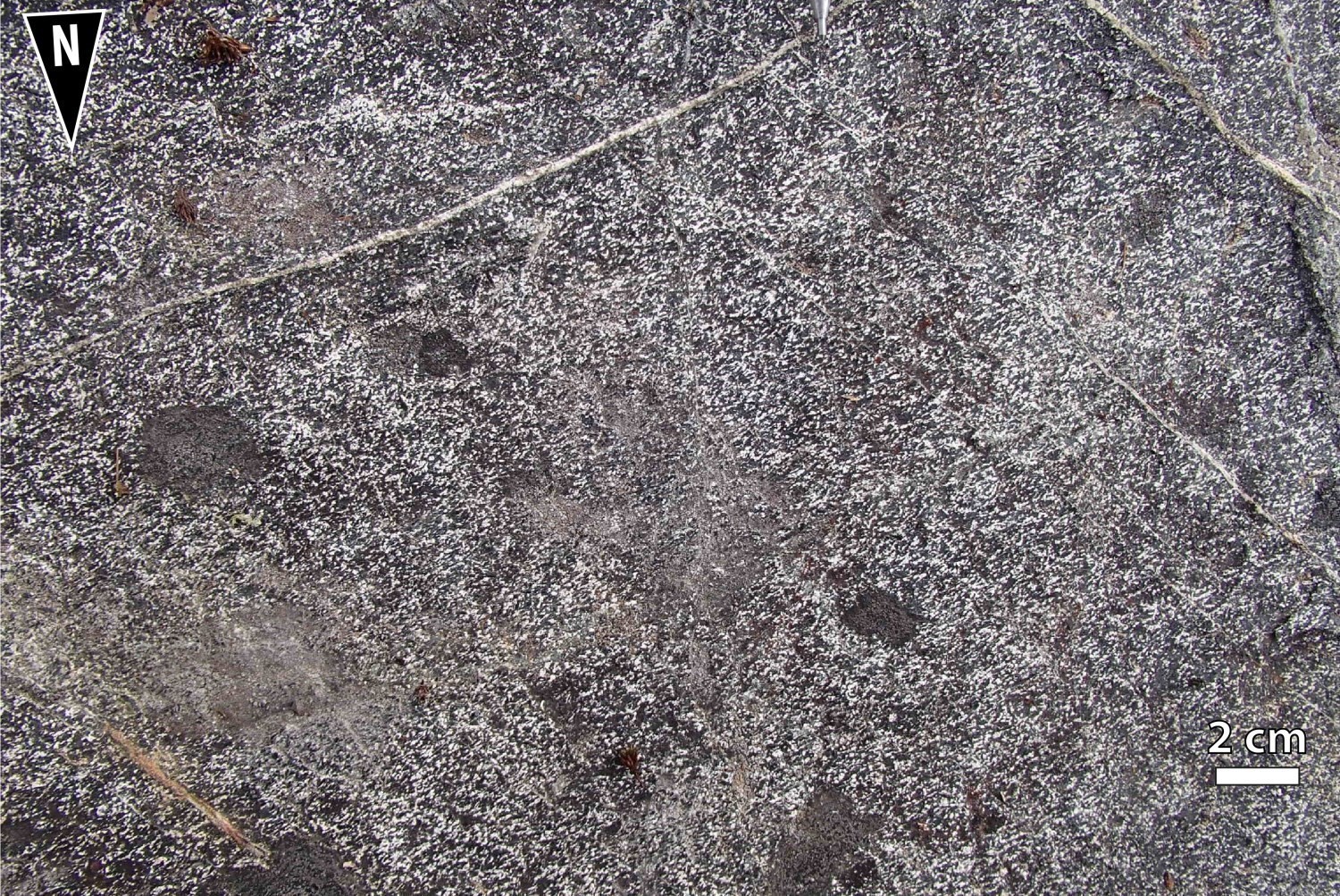
 The Digne Pluton contains numerous enclaves of amphibolite, amphibolitized gabbro, diorite, quartz diorite and pyroxenite, some of which have been identified as lithological units on geological maps of the Cadieux Lake (Beauchamp, 2020) and Bohier Island (Beauchamp et al., 2018) areas. These enclaves are, in the majority of cases, heavily deformed. They correspond to L/S tectonites. The mineral lineation is recrystallized and marked by stretching of hornblende. Enclaves are medium to coarse grained and granoblastic. They contain hornblende, plagioclase and varying amounts of clinopyroxene, magnetite and biotite. The Digne Pluton is cut by undifferentiated granitic (aplitic to pegmatitic) intrusions, some of which are associated with the Wahemen Suite.
The Digne Pluton contains numerous enclaves of amphibolite, amphibolitized gabbro, diorite, quartz diorite and pyroxenite, some of which have been identified as lithological units on geological maps of the Cadieux Lake (Beauchamp, 2020) and Bohier Island (Beauchamp et al., 2018) areas. These enclaves are, in the majority of cases, heavily deformed. They correspond to L/S tectonites. The mineral lineation is recrystallized and marked by stretching of hornblende. Enclaves are medium to coarse grained and granoblastic. They contain hornblende, plagioclase and varying amounts of clinopyroxene, magnetite and biotite. The Digne Pluton is cut by undifferentiated granitic (aplitic to pegmatitic) intrusions, some of which are associated with the Wahemen Suite.
Geochemical analyses of samples collected during summer 2018 mapping (Beauchamp, 2020) indicate that the Digne Pluton is composed of tonalitic and granodioritic rocks (Debon and Lefort, 1983). These rocks are mostly magnesian, peraluminous and type I granitoids (Maniar and Picolli, 1989). Samples, of calcic to calc-alkaline affinity (Frost et al., 2001), plot in the volcanic arc granite field. The rare earth diagram normalized to CI chondrite (Palme and O’Neill, 2004) shows light rare earth enrichment over heavy rare earths. Finally, the spider diagram normalized to the primitive mantle (McDonough and Sun, 1995) shows negative anomalies in Nb, P, Sm and Ti, and positive anomalies in Ta, La, Ce, Nd, Zr and Hf.
Thickness and Distribution
The Digne Pluton is elongated. It extends 30 km in an ENE-WSW direction, from north of Lépante Lake (sheet 33A07) to Bohier Island (sheet 33A08). It has a maximum width of 9 km and covers an area of 210 km2.
Dating
A leucotonalite (L>>S tectonite) located ~10 m from the north contact with rocks of the Upper Eastmain Greenschist Belt (UEGB) was sampled for isotopic dating (outcrop 18-AB-1085).
| Unit | Sample Number | Isotopic System | Mineral | Crystallization Age (Ma) | (+) | (-) | Reference(s) |
| mAdig | 18-AB-1085A | U-Pb | Zircon | 2814 | 7 | 7 | Davis, 2019 |
Stratigraphic Relationship(s)

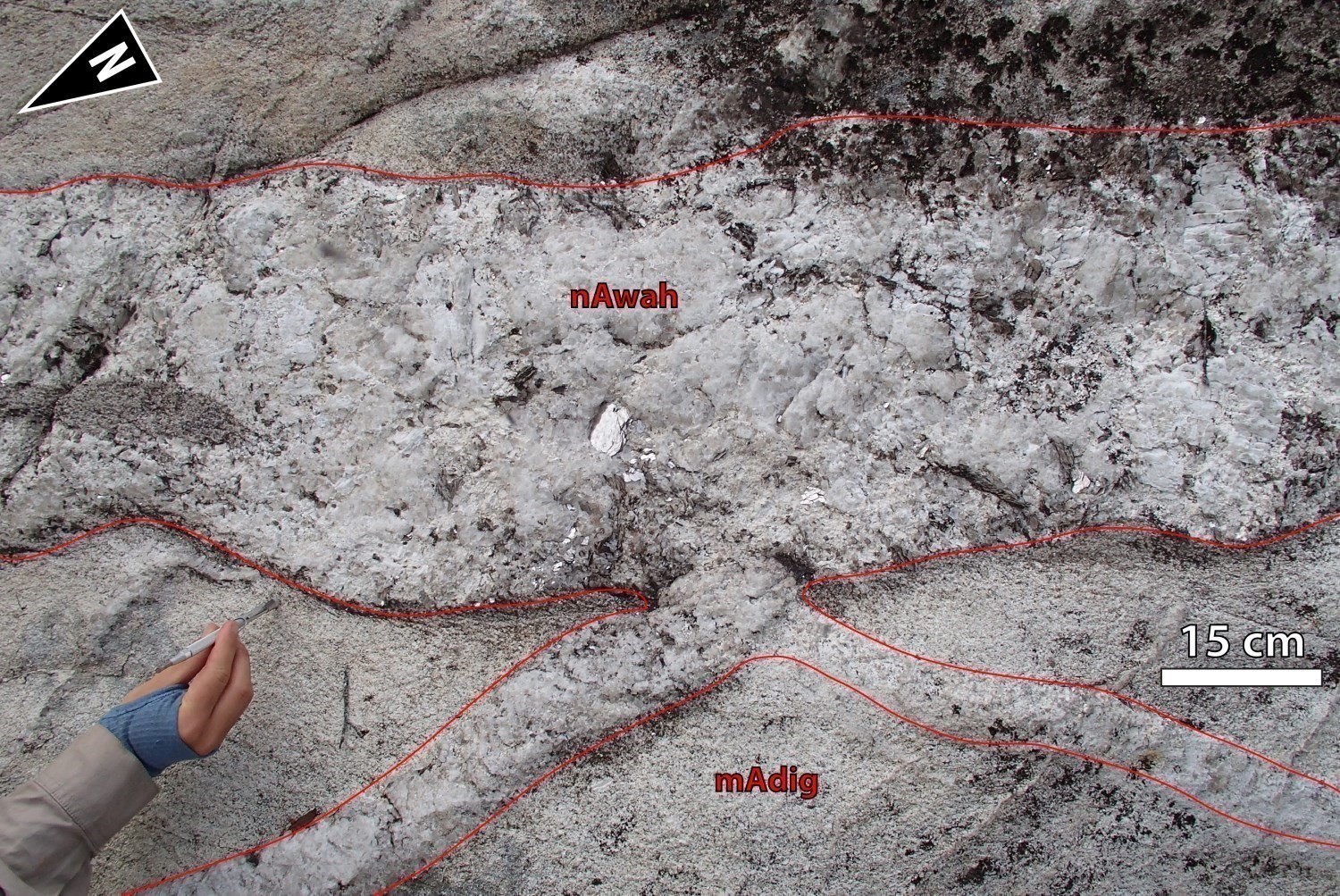 The Digne Pluton intrudes into the oldest phases of the Misasque Complex. It is cut by centimetric to decimetric intrusions of massive to foliated granite and by two mica pegmatites belonging to the Wahemen Suite. Some small intrusive masses have been individualized on the Cadieux Lake geological map (Beauchamp, 2020).
The Digne Pluton intrudes into the oldest phases of the Misasque Complex. It is cut by centimetric to decimetric intrusions of massive to foliated granite and by two mica pegmatites belonging to the Wahemen Suite. Some small intrusive masses have been individualized on the Cadieux Lake geological map (Beauchamp, 2020).
Paleontology
Does not apply.
References
Publications Available Through Sigéom Examine
BEAUCHAMP, A.-M. 2020. Géologie et potentiel minéral de la région du lac Cadieux, sous-provinces d’Opatica et d’Opinaca, Eeyou Istchee Baie-James, Québec, Canada. MERN. BG 2019-02, 2 plans.
BEAUCHAMP, A.-M., MASSEI, F., DAOUDENE, Y. 2018. Géologie de la région de l’île Bohier, au contact entre les sous-provinces d’Opatica, d’Opinaca et le bassin d’Otish, au nord de Mistissini, Eeyou Istchee Baie-James, Québec, Canada. MERN. BG 2018-02, 2 plans.
DAVIS, D W. 2019. Rapport sur les datations U-Pb de roches du Québec 2018-2019, projets Lac Cadieux et Lac Watts. UNIVERSITY OF TORONTO. MB 2019-09, 82 pages.
Other Publications
DEBON, F., LEFORT, P. 1983. A chemical-mineralogical classification of common plutonic rocks and associations. Transactions of the Royal Society of Edinburgh, Earth Sciences; volume 73, pages 135–149. doi.org/10.1017/S0263593300010117.
FROST, B.R., BARNES, C.G., COLLINS, W.J., ARCULUS, R.J., ELLIS, D.J., Frost, C.D. 2001. A geochemical classification for granitic rocks. Journal of Petrology; volume 12, numéro 11, pages 2033-2048. doi.org/10.1093/petrology/42.11.2033.
MANIAR, P.D., PICCOLI, P.M. 1989. Tectonic discrimination of granitoids. Geological Society of America Bulletin; volume 101, pages 635–643. doi.org/10.1130/0016-7606(1989)101<0635:TDOG>2.3.CO;2.
MCDONOUGH, W.F., SUN, S.S. 1995. The composition of the earth. Chemical Geology; volume 120, pages 223-253. doi.org/10.1016/0009-2541(94)00140-4.
PALME, H., O’NEILL, H.S.C. 2004. Cosmochemical estimates of mantle composition. In: Treatise on Geochemistry. (Holland, H.D. and Turrekian, K.K. editors), Elsevier, Amsterdam, The Netherlands; volume 2, pages 1-38. doi.org/10.1016/B978-0-08-095975-7.00201-1.
Suggested Citation
Ministère de l’Énergie et des Ressources naturelles (MERN). Digne Pluton. Quebec Stratigraphic Lexicon. https://gq.mines.gouv.qc.ca/lexique-stratigraphique/province-du-superieur/suite-intrusive-de-digne_en [accessed on Day Month Year].
Contributors
|
First publication |
Anne-Marie Beauchamp, Eng., M.Sc. anne-marie.beauchamp@mern.gouv.qc.ca (redaction) Mehdi A. Guemache, P. Geo., Ph.D. (coordination); Patrice Roy, P. Geo., M.Sc. (critical review); Simon Auclair, P. Geo., M.Sc. (editing); Céline Dupuis, P. Geo., Ph.D. (English version); Ricardo Escobar Moran (HTML editing). |

